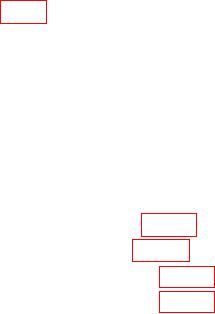
TB 9-6625-1963-24
(6) Connect function generator to TI B input, and connect oscilloscope probe to test
point TP141 (fig. 2).
(7) Set TRIGGER SOURCE INPUT B switch to input B (in) and B P-P SENS
switch to 1V.
(8) Adjust function generator amplitude to obtain a 4-division vertical deflection on
oscilloscope. If roll off or spikes on square wave exceed 0.32 major division,
perform b (3) below.
(9) Set B P-P SENS switch to 10V and repeat technique of (8) above. If roll off or
spikes on square wave exceed 0.32 major division, perform b (4) below.
b. Adjustments
(1) Adjust C12 and C13 (fig. 2) for best flatness of square wave (R).
(2) Adjust C9 and C10 (fig. 2) for best flatness of square wave (R).
(3) Adjust C112 and C113 (fig. 1) for best flatness of square wave (R).
(4) Adjust C109 and C110 (fig. 1) for best flatness of square wave (R).
11. Input Sensitivity
a. Performance Check
f
(1) Connect signal generator to TI B FREQ IN jack, using a 50
eedthrough termination.
minimum output.
(3) Position TI controls as listed in (a) through (e) below:
MODE pushbutton switch to FREQ B.
(a)
TIME pushbutton switch to 10ms.
(b)
SOURCE INPUT B pushbutton switch to B (in).
(c)
A and B P-P SENS switches to 1V.
(d)
A and B LEVEL controls to PRESET.
(e)
(4) Slowly increase signal generator amplitude until test oscilloscope displays stable
count of applied frequency. Signal generator amplitude will not exceed 53 mV rms.
(5) Reduce signal generator frequency to 100 MHz and amplitude to minimum.
(6) Move signal generator connection to TI A input jack.
(7) Position TI controls as listed in (a) through (c) below:
(a) MODE pushbutton switch to PERIOD A.
(b) AVERG pushbutton switch to X1000.
(c) CLOCK pushbutton switch to 10ns.
(8) Slowly increase signal generator amplitude until test oscilloscope displays a
stable indication of approximately 10 ns. Signal generator amplitude will not exceed 53 mV
rms.
b. Adjustments. No adjustments can be made.

